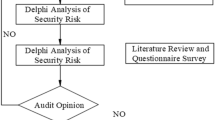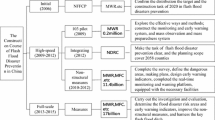Abstract
Large-scale Early Warning (EW) is an indispensable component for protecting national information infrastructure. Various qualitative and quantitative models of Security Risk Assessment (SRA) are surveyed and evaluated in this paper. Then, the paper proposes a hierarchical on-line SRA model for three levels of subsystems in an EW system, i.e., local EW groups, regional EW centers, and the national EW center. In this model, the SRA system in a regional EW center evaluates the threat, vulnerability, impact, and control of each local group to calculate the local residue risk value, and calculates the regional residue risk value and reports it to the national EW center. To compute the national residue risk value, the SRA system in the national EW center synthesizes reports and values from all regional centers. A prototype of the hierarchical on-line SRA model was implemented in an EW system. Experimental results show the effectiveness of the proposed method.
Work is supported by the National Natural Science Foundation of China, under Grant 60303012, 90104001 and National High Technology (863) Program No. 2003AA142010.
Access this chapter
Tax calculation will be finalised at checkout
Purchases are for personal use only
Preview
Unable to display preview. Download preview PDF.
Similar content being viewed by others
References
Sandia National Laboratories: Us Infrastructure Assurance Strategic Roadmaps – Strategies For Preserving Our National Security (August 1998)
The International Organization for Standardization: Common Criteria for Information Technology Security Evaluation. ISO/IEC15408: 1999(E) (1999)
SSE-CMM Model Description Document Version 2.0 (1999), http://www.sse-cmm.org
International Organization for Standardization: BS ISO/IEC 17799:2000 Information Technology – Code of Practice for Information Security Management (December 2000)
BSI/DISC Committee BDD/2: BS7799 Code of Practice for Information Security Management (1999)
International Organization for Standardization: ISO/IEC TR 13335, Information Technology – Guidelines for the Management of IT Security (GMITS) (1996-2001)
National Security Agency: Information Assurance Technical Framework (IATF), Version 3.0 (2000), http://www.iatf.net
Stoneburner, G., Goguen, A., Feringa, A.: Risk Management Guide for Information Technology Systems. Recommendations of the National Institute of Standards and Technology (NIST). NIST Special Publication 800-30 (October 2001)
Alberts, C.J., Dorofee, A.J.: OCTAVESM Method Implementation Guide, v2.0. Pittsburgh, PA: Software Engineering Institute, Carnegie Mellon University (2001)
C&A Systems Security Ltd.: COBRA: Introduction to Risk Analysis, http://www.ca-systems.zetnet.co.uk/risk.htm
Rathmell, A., Overill, R., Valeri, L.: Information Warfare Attack Assessment System (IWAAS). Information Warfare Seminar. London (October 1997)
Xujia, X., Chuang, L., Yixin, J.: A Survey of Computer Vulnerability Assessment. Chinese Journal of Computers 27(1), 1–11 (2004)
Butler, S.A.: Security Attribute Evaluation Method. CMU-CS-03-132. Submitted in partial fulfillment of the requirements for the Degree of Doctor of Philosophy. School of Computer Science Carnegie Mellon University, Pittsburgh. PA 15213 (May 2003)
International Information System Security Certification Consortium (ISC)2: Security management, http://www.os-global.com/
Tan, D.: Quantitative Risk Analysis Step-By-Step. GSEC Practical Version 1.4b – Option 1. As part of the Information Security Reading Room. SANS Institute (2003)
Peltier, T.R.: Information Security Risk Analysis. Auerbach Publications, New York (2001)
List of Risk Analysis, Assessment and Management Tools (1998), http://www.theiia.org/ITAuidit
Meritt, J.W.: CISSP.: A Method for Quantitative Risk Analysis, http://www.auditnet.org/docs/riskmeth.PDF
Qing, M.: Characteristic Information Fusion Method on Network Security Strategic Indication/ Warning System. Computer Engineering 28(7) (2002)
Author information
Authors and Affiliations
Editor information
Editors and Affiliations
Rights and permissions
Copyright information
© 2004 Springer-Verlag Berlin Heidelberg
About this paper
Cite this paper
Xuan, L., Xu, X. (2004). Research on a Quantitative Security Risk Assessment Approach in Large-Scale Early Warning System. In: Jin, H., Pan, Y., Xiao, N., Sun, J. (eds) Grid and Cooperative Computing - GCC 2004 Workshops. GCC 2004. Lecture Notes in Computer Science, vol 3252. Springer, Berlin, Heidelberg. https://doi.org/10.1007/978-3-540-30207-0_61
Download citation
DOI: https://doi.org/10.1007/978-3-540-30207-0_61
Publisher Name: Springer, Berlin, Heidelberg
Print ISBN: 978-3-540-23578-1
Online ISBN: 978-3-540-30207-0
eBook Packages: Springer Book Archive




